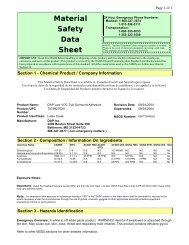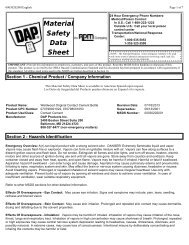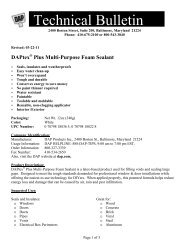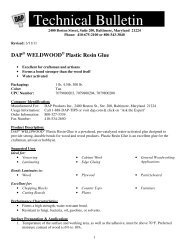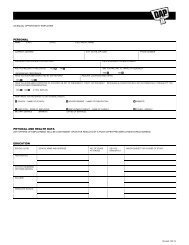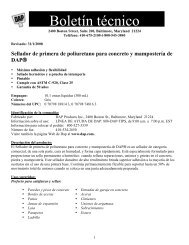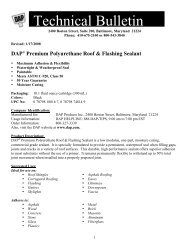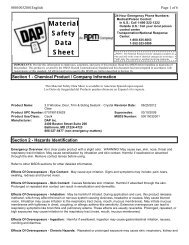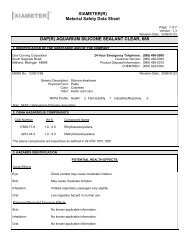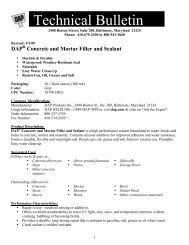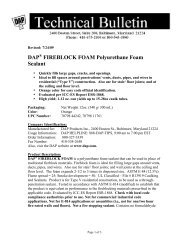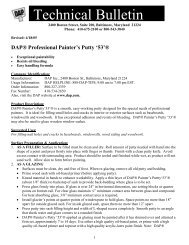XIAMETER(R) Material Safety Data Sheet DAP(R)SILICONE PLUS ...
XIAMETER(R) Material Safety Data Sheet DAP(R)SILICONE PLUS ...
XIAMETER(R) Material Safety Data Sheet DAP(R)SILICONE PLUS ...
Create successful ePaper yourself
Turn your PDF publications into a flip-book with our unique Google optimized e-Paper software.
<strong>XIAMETER</strong>(R)<br />
<strong>Material</strong> <strong>Safety</strong> <strong>Data</strong> <strong>Sheet</strong><br />
Page: 1 of 9<br />
Version: 1.0<br />
Revision Date: 2007/11/14<br />
<strong>DAP</strong>(R)<strong>SILICONE</strong> <strong>PLUS</strong> PREMIUM <strong>SILICONE</strong> RUBBER SEALANT KITCHEN &<br />
BATH ALMON<br />
1. IDENTIFICATION OF THE SUBSTANCE AND OF THE COMPANY<br />
Dow Corning Corporation<br />
South Saginaw Road<br />
Midland, Michigan 48686<br />
24 Hour Emergency Telephone:<br />
Customer Service:<br />
Product Disposal Information:<br />
CHEMTREC:<br />
(989) 496-5900<br />
(989) 496-6000<br />
(989) 496-6315<br />
(800) 424-9300<br />
MSDS No.: 04080677 Revision Date: 2007/11/14<br />
Generic Description: Silicone Sealant<br />
Physical Form: Paste<br />
Color: See product name<br />
Odor: Some odor<br />
Note: NFPA = National Fire Protection Association<br />
2. HAZARDS IDENTIFICATION<br />
Acute Effects<br />
NFPA Profile: Health 2 Flammability 1 Instability/Reactivity 0<br />
POTENTIAL HEALTH EFFECTS<br />
Eye:<br />
Skin:<br />
Inhalation:<br />
Oral:<br />
Direct contact may cause mild irritation.<br />
May cause moderate irritation.<br />
Irritates respiratory passages very slightly. Vapor overexposure may cause drowsiness.<br />
Low ingestion hazard in normal use.<br />
Prolonged/Repeated Exposure Effects<br />
Skin:<br />
Inhalation:<br />
Oral:<br />
Overexposure may injure internally if absorbed. Repeated skin contact may cause allergic<br />
skin reaction.<br />
Overexposure by inhalation may injure the following organ(s): Blood.Liver.<br />
Repeated ingestion or swallowing large amounts may injure internally.<br />
Signs and Symptoms of Overexposure<br />
No known applicable information.<br />
Medical Conditions Aggravated by Exposure<br />
No known applicable information.
<strong>XIAMETER</strong>(R)<br />
<strong>Material</strong> <strong>Safety</strong> <strong>Data</strong> <strong>Sheet</strong><br />
Page: 2 of 9<br />
Version: 1.0<br />
Revision Date: 2007/11/14<br />
<strong>DAP</strong>(R)<strong>SILICONE</strong> <strong>PLUS</strong> PREMIUM <strong>SILICONE</strong> RUBBER SEALANT KITCHEN &<br />
BATH ALMON<br />
The above listed potential effects of overexposure are based on actual data, results of studies performed upon similar compositions,<br />
component data and/or expert review of the product. Please refer to Section 11 for the detailed toxicology information.<br />
3. COMPOSITION/INFORMATION ON INGREDIENTS<br />
CAS Number Wt % Component Name<br />
64742-46-7 3.0 - 7.0 Hydrotreated middle petroleum distillates<br />
22984-54-9 1.0 - 5.0 Methyl tri(ethylmethylketoxime) silane<br />
96-29-7 1.0 - 5.0 Methylethylketoxime<br />
The above components are hazardous as defined in 29 CFR 1910.1200.<br />
4. FIRST AID MEASURES<br />
Eye:<br />
Skin:<br />
Inhalation:<br />
Oral:<br />
Notes to Physician:<br />
Immediately flush with water for 15 minutes.<br />
Remove from skin and immediately flush with water for 15 minutes. Get medical attention if<br />
irritation or ill effects develop or persist.<br />
Remove to fresh air. Get medical attention if ill effects persist.<br />
Get medical attention.<br />
Treat according to person's condition and specifics of exposure.<br />
5. FIRE FIGHTING MEASURES<br />
Flash Point:<br />
Not applicable.<br />
Autoignition Temperature: Not determined.<br />
Flammability Limits in Air:<br />
Extinguishing Media:<br />
Fire Fighting Measures:<br />
Unusual Fire Hazards:<br />
Not determined.<br />
On large fires use dry chemical, foam or water spray. On small fires use carbon dioxide<br />
(CO2), dry chemical or water spray. Water can be used to cool fire exposed containers.<br />
Self-contained breathing apparatus and protective clothing should be worn in fighting large<br />
fires involving chemicals. Determine the need to evacuate or isolate the area according to<br />
your local emergency plan. Use water spray to keep fire exposed containers cool.<br />
None.<br />
6. ACCIDENTAL RELEASE MEASURES
<strong>XIAMETER</strong>(R)<br />
<strong>Material</strong> <strong>Safety</strong> <strong>Data</strong> <strong>Sheet</strong><br />
Page: 3 of 9<br />
Version: 1.0<br />
Revision Date: 2007/11/14<br />
<strong>DAP</strong>(R)<strong>SILICONE</strong> <strong>PLUS</strong> PREMIUM <strong>SILICONE</strong> RUBBER SEALANT KITCHEN &<br />
BATH ALMON<br />
Containment/Clean up: Observe all personal protection equipment recommendations described in Sections 5 and 8.<br />
Wipe up or scrape up and contain for salvage or disposal. Clean area as appropriate since<br />
spilled materials, even in small quantities, may present a slip hazard. Final cleaning may<br />
require use of steam, solvents or detergents. Dispose of saturated absorbant or cleaning<br />
materials appropriately, since spontaneous heating may occur. Local, state and federal laws<br />
and regulations may apply to releases and disposal of this material, as well as those materials<br />
and items employed in the cleanup of releases. You will need to determine which federal,<br />
state and local laws and regulations are applicable. Sections 13 and 15 of this MSDS provide<br />
information regarding certain federal and state requirements.<br />
Note: See section 8 for Personal Protective Equipment for Spills. Call (989) 496-5900, if additional information is<br />
required.<br />
7. HANDLING AND STORAGE<br />
Use with adequate ventilation. Product evolves methyl ethyl ketoxime (MEKO) when exposed to water or humid air.<br />
Provide ventilation during use to control methyl ethyl ketoxime (MEKO) within exposure guidelines or use respiratory<br />
protection. Avoid eye contact. Avoid skin contact. Avoid breathing vapor, mist, dust, or fumes. Keep container closed.<br />
Do not take internally.<br />
Use reasonable care and store away from oxidizing materials. Keep container closed and store away from water or<br />
moisture.<br />
8. EXPOSURE CONTROLS / PERSONAL PROTECTION<br />
Component Exposure Limits<br />
CAS Number Component Name Exposure Limits<br />
64742-46-7 Hydrotreated middle petroleum distillates OSHA PEL (final rule) and ACGIH TLV for oil mists: TWA 5<br />
mg/m3.<br />
22984-54-9 Methyl tri(ethylmethylketoxime) silane See ethyl methyl ketoxime comments.<br />
96-29-7 Methylethylketoxime Vendor guide: TWA 3 ppm, STEL 10 ppm. AIHA WEEL:<br />
TWA 10 ppm.<br />
Ethyl methyl ketoxime is formed upon contact with water or humid air. Provide adequate ventilation to control<br />
exposures within the following exposure guidelines: Vendor guide TWA: 3 ppm, STEL: 10 ppm; AIHA WEEL TWA: 10<br />
ppm.<br />
Engineering Controls<br />
Local Ventilation:<br />
General Ventilation:<br />
Recommended.<br />
Recommended.
<strong>XIAMETER</strong>(R)<br />
<strong>Material</strong> <strong>Safety</strong> <strong>Data</strong> <strong>Sheet</strong><br />
Page: 4 of 9<br />
Version: 1.0<br />
Revision Date: 2007/11/14<br />
<strong>DAP</strong>(R)<strong>SILICONE</strong> <strong>PLUS</strong> PREMIUM <strong>SILICONE</strong> RUBBER SEALANT KITCHEN &<br />
BATH ALMON<br />
Personal Protective Equipment for Routine Handling<br />
Eyes:<br />
Skin:<br />
Suitable Gloves:<br />
Inhalation:<br />
Suitable Respirator:<br />
Use proper protection - safety glasses as a minimum.<br />
Wash at mealtime and end of shift. If skin contact occurs, change contaminated clothing as<br />
soon as possible and thoroughly flush affected areas with cool water. Chemical protective<br />
gloves are recommended.<br />
Avoid skin contact by implementing good industrial hygiene practices and procedures. Select<br />
and use gloves and/or protective clothing to further minimize the potential for skin contact.<br />
Consult with your glove and/or personnel protective equipment manufacturer for selection of<br />
appropriate compatible materials.<br />
Use respiratory protection unless adequate local exhaust ventilation is provided or exposure<br />
assessment demonstrates that exposures are within recommended exposure guidelines. IH<br />
personnel can assist in judging the adequacy of existing engineering controls.<br />
General and local exhaust ventilation is recommended to maintain vapor exposures below<br />
recommended limits. Where concentrations are above recommended limits or are unknown,<br />
appropriate respiratory protection should be worn. Follow OSHA respirator regulations (29<br />
CFR 1910.134) and use NIOSH/MSHA approved respirators.<br />
Personal Protective Equipment for Spills<br />
Eyes:<br />
Skin:<br />
Inhalation/Suitable<br />
Respirator:<br />
Precautionary Measures:<br />
Comments:<br />
Use full face respirator.<br />
Wash at mealtime and end of shift. If skin contact occurs, change contaminated clothing as<br />
soon as possible and thoroughly flush affected areas with cool water. Chemical protective<br />
gloves are recommended.<br />
Respiratory protection recommended. Follow OSHA Respirator Regulations (29 CFR<br />
1910.134) and use NIOSH/MHSA approved respirators. Protection provided by air purifying<br />
respirators against exposure to any hazardous chemical is limited. Use a positive pressure air<br />
supplied respirator if there is any potential for uncontrolled release, exposure levels are<br />
unknown, or any other circumstance where air purifying respirators may not provide adequate<br />
protection.<br />
Avoid eye contact. Avoid skin contact. Avoid breathing vapor, mist, dust, or fumes. Keep<br />
container closed. Do not take internally. Use reasonable care.<br />
Product evolves methyl ethyl ketoxime (MEKO) when exposed to water or humid air. Provide<br />
ventilation during use to control methyl ethyl ketoxime (MEKO) within exposure guidelines or<br />
use respiratory protection.<br />
Note: These precautions are for room temperature handling. Use at elevated temperature or aerosol/spray applications may require<br />
added precautions.<br />
9. PHYSICAL AND CHEMICAL PROPERTIES
<strong>XIAMETER</strong>(R)<br />
<strong>Material</strong> <strong>Safety</strong> <strong>Data</strong> <strong>Sheet</strong><br />
Page: 5 of 9<br />
Version: 1.0<br />
Revision Date: 2007/11/14<br />
<strong>DAP</strong>(R)<strong>SILICONE</strong> <strong>PLUS</strong> PREMIUM <strong>SILICONE</strong> RUBBER SEALANT KITCHEN &<br />
BATH ALMON<br />
Physical Form: Paste<br />
Color: See product name<br />
Odor: Some odor<br />
Specific Gravity @ 25°C: 1.32<br />
Viscosity: Not determined.<br />
Freezing/Melting Point: Not determined.<br />
Boiling Point: Not determined.<br />
Vapor Pressure @ 25°C: Not determined.<br />
Vapor Density: Not determined.<br />
Solubility in Water: Not determined.<br />
pH: Not determined.<br />
Volatile Content: Not determined.<br />
Flash Point: Not applicable.<br />
Autoignition Temperature: Not determined.<br />
Flammability Limits in Air: Not determined.<br />
Note: The above information is not intended for use in preparing product specifications.<br />
10. STABILITY AND REACTIVITY<br />
Chemical Stability:<br />
Hazardous<br />
Polymerization:<br />
Conditions to Avoid:<br />
<strong>Material</strong>s to Avoid:<br />
Stable.<br />
Hazardous polymerization will not occur.<br />
None.<br />
Oxidizing material can cause a reaction. Water, moisture, or humid air can cause hazardous<br />
vapors to form as described in Section 8.<br />
Hazardous Decomposition Products<br />
Thermal breakdown of this product during fire or very high heat conditions may evolve the following decomposition<br />
products: Carbon oxides and traces of incompletely burned carbon compounds. Metal oxides. Formaldehyde. Silicon<br />
dioxide. Nitrogen oxides. Quartz. Sulfur oxides.<br />
11. TOXICOLOGICAL INFORMATION<br />
Component Toxicology Information<br />
Methyl Ethyl Ketoxime (MEKO) is formed upon contact with water or humid air. Male rodents exposed to MEKO vapor<br />
throughout their lifetime developed liver cancer. Additional testing is planned by the MEKO supplier to determine any<br />
relevance to humans. Until more data is known, exposure levels should be maintained as low as achievable.<br />
Contains Methyl Ethyl Ketoxime (MEKO). Male rodents exposed to MEKO vapor throughout their lifetime developed liver<br />
cancer. Additional testing is planned by the MEKO supplier to determine any relevance to humans. Until more data is
<strong>XIAMETER</strong>(R)<br />
<strong>Material</strong> <strong>Safety</strong> <strong>Data</strong> <strong>Sheet</strong><br />
Page: 6 of 9<br />
Version: 1.0<br />
Revision Date: 2007/11/14<br />
<strong>DAP</strong>(R)<strong>SILICONE</strong> <strong>PLUS</strong> PREMIUM <strong>SILICONE</strong> RUBBER SEALANT KITCHEN &<br />
BATH ALMON<br />
known, exposure levels should be maintained as low as achievable.<br />
Special Hazard Information on Components<br />
Sensitizers<br />
CAS Number Wt % Component Name<br />
22984-54-9 1.0 - 5.0 Methyl tri(ethylmethylketoxime) silane Possible skin sensitizer.<br />
96-29-7 1.0 - 5.0 Methylethylketoxime Possible skin sensitizer.<br />
12. ECOLOGICAL INFORMATION<br />
Environmental Fate and Distribution<br />
Complete information is not yet available.<br />
Environmental Effects<br />
Complete information is not yet available.<br />
Fate and Effects in Waste Water Treatment Plants<br />
Complete information is not yet available.<br />
Ecotoxicity Classification Criteria<br />
Hazard Parameters (LC50 or EC50) High Medium Low<br />
Acute Aquatic Toxicity (mg/L) 1 and 100<br />
Acute Terrestrial Toxicity 100 and 2000<br />
This table is adapted from "Environmental Toxicology and Risk Assessment", ASTM STP 1179, p.34, 1993.<br />
This table can be used to classify the ecotoxicity of this product when ecotoxicity data is listed above. Please read the other information presented in the<br />
section concerning the overall ecological safety of this material.<br />
13. DISPOSAL CONSIDERATIONS<br />
RCRA Hazard Class (40 CFR 261)<br />
When a decision is made to discard this material, as received, is it classified as a hazardous waste? No<br />
State or local laws may impose additional regulatory requirements regarding disposal.Call (989) 496-6315, if additional<br />
information is required.<br />
14. TRANSPORT INFORMATION<br />
DOT Road Shipment Information (49 CFR 172.101)
<strong>XIAMETER</strong>(R)<br />
<strong>Material</strong> <strong>Safety</strong> <strong>Data</strong> <strong>Sheet</strong><br />
Page: 7 of 9<br />
Version: 1.0<br />
Revision Date: 2007/11/14<br />
<strong>DAP</strong>(R)<strong>SILICONE</strong> <strong>PLUS</strong> PREMIUM <strong>SILICONE</strong> RUBBER SEALANT KITCHEN &<br />
BATH ALMON<br />
Not subject to DOT.<br />
Ocean Shipment (IMDG)<br />
Not subject to IMDG code.<br />
Air Shipment (IATA)<br />
Not subject to IATA regulations.<br />
Call Dow Corning Transportation, (989) 496-8577, if additional information is required.<br />
15. REGULATORY INFORMATION<br />
Contents of this MSDS comply with the OSHA Hazard Communication Standard 29 CFR 1910.1200.<br />
TSCA Status:<br />
All chemical substances in this material are included on or exempted from listing on the TSCA<br />
Inventory of Chemical Substances.<br />
EPA SARA Title III Chemical Listings<br />
Section 302 Extremely Hazardous Substances (40 CFR 355):<br />
None.<br />
Section 304 CERCLA Hazardous Substances (40 CFR 302):<br />
None.<br />
Section 311/312 Hazard Class (40 CFR 370):<br />
Acute: Yes<br />
Chronic: Yes<br />
Fire: No<br />
Pressure: No<br />
Reactive: No<br />
Section 313 Toxic Chemicals (40 CFR 372):<br />
None present or none present in regulated quantities.<br />
Note: Chemicals are listed under the 313 Toxic Chemicals section only if they meet or exceed a reporting threshold.<br />
Supplemental State Compliance Information<br />
California<br />
Warning: This product contains the following chemical(s) listed by the State of California under the Safe Drinking Water<br />
and Toxic Enforcement Act of 1986 (Proposition 65) as being known to cause cancer, birth defects or other<br />
reproductive harm.
<strong>XIAMETER</strong>(R)<br />
<strong>Material</strong> <strong>Safety</strong> <strong>Data</strong> <strong>Sheet</strong><br />
Page: 8 of 9<br />
Version: 1.0<br />
Revision Date: 2007/11/14<br />
<strong>DAP</strong>(R)<strong>SILICONE</strong> <strong>PLUS</strong> PREMIUM <strong>SILICONE</strong> RUBBER SEALANT KITCHEN &<br />
BATH ALMON<br />
None known.<br />
Massachusetts<br />
CAS Number Wt % Component Name<br />
1317-65-3
<strong>XIAMETER</strong>(R)<br />
<strong>Material</strong> <strong>Safety</strong> <strong>Data</strong> <strong>Sheet</strong><br />
Page: 9 of 9<br />
Version: 1.0<br />
Revision Date: 2007/11/14<br />
<strong>DAP</strong>(R)<strong>SILICONE</strong> <strong>PLUS</strong> PREMIUM <strong>SILICONE</strong> RUBBER SEALANT KITCHEN &<br />
BATH ALMON<br />
7631-86-9


